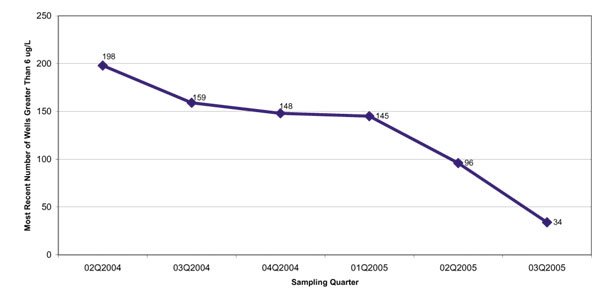Olin releases test results showing number of wells that exceed
health goal are down; Experts say it’s too soon to tell if chemical
is dissipating or if results are temporary
San Martin – New test results show that perchlorate concentrations in South County groundwater are dropping dramatically.
In three rounds of testing this year, the number of wells found to exceed the state’s public health goal for the contaminant has fallen from 145 to 96 to 34. A total of 850 wells were tested. Last year, in a smaller sample, 198 wells tested above 6 parts per billion.
Perchlorate is a sodium known to disrupt thyroid function that’s used to produce rocket engines and road flares. It also occurs naturally in some fertilizers and has been detected in lightning. Its presence in South County’s groundwater was discovered in a routine environmental evaluation when the Olin Corp., which made road flares in Morgan Hill from 1955 to 1987, tried to sell its factory.
The test results, released by Olin last week, are getting a mixed response from water experts who say it’s far too soon to know whether perchlorate is actually dissipating or if the results will prove temporary.
“I’m glad people’s wells are below [6 parts per billion] because the fewer wells below six, the fewer people are impacted,” said David Athey, who’s overseeing Olin’s cleanup effort for the Central Coast Regional Water Resources Control Board. “I always have a cautious eye on data because the proof is in long-term monitoring. I don’t think it’s natural remediation. It’s not disappearing.”
Athey said the more than 100 wells with indeterminate results show the impossibility of drawing conclusions about the contamination after only two years of testing.
“It’s important that there are so many with no trend,” he said. “I would want to see at least [another] two or three years of data.”
Perchlorate has been detected in South County from Morgan Hill to the northern and eastern edges of Gilroy. One possible explanation for the drop is that last season’s heavy rains diluted the perchlorate in the groundwater. Athey said a drought could cause an equally dramatic increase in perchlorate concentration.
Tracy Hemmeter, of the Santa Clara Valley Water District, noted that the overall size of the 9.5-mile plume south of the former Tenant Avenue factory, has not changed, and that many wells on the fringes of the plume have not shown a decrease in contamination.
“It’s great that perchlorate concentrations are down,” Hemmeter said. “But this shows how important it is to continue to investigate and characterize the groundwater basin.”
Olin is currently testing wells and will present new results early next year. By June 2006, the company must present a plan to clean the southern plume.
Since the contamination was revealed in 2003, the company has provided bottled water to any resident south of Morgan Hill who’s well water tests above 4 parts per billion. In June, the company won the right to raise the threshold to 6 parts per billion to match the public health goal. More than 100 residents may lose their alternative water supply next year.














